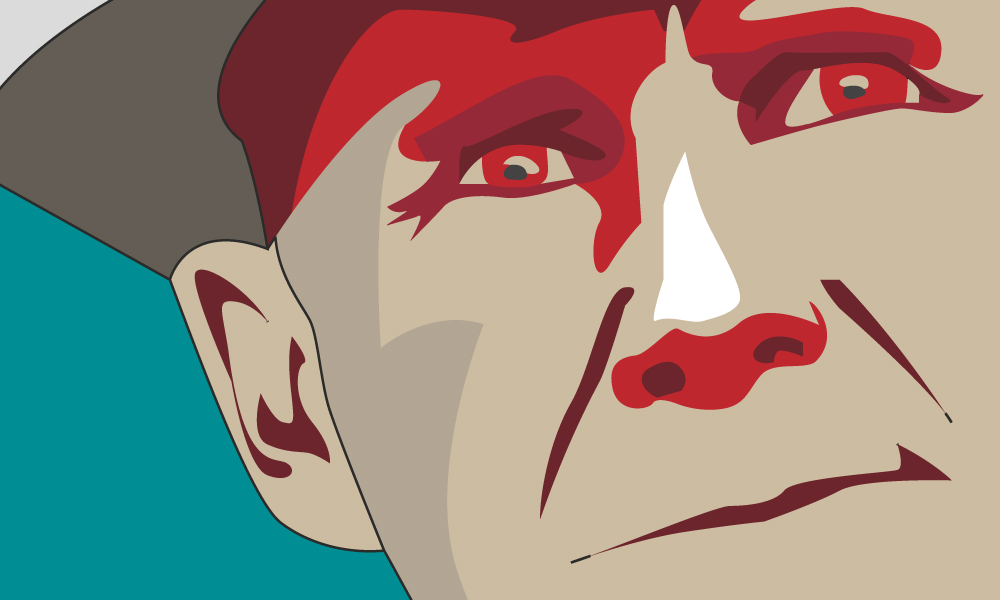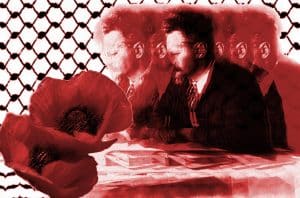Much of U.S. political commentary today oozes with pessimism: red-blue tribalism, the government shutdown, the alt-right … the list of fracture points is long. But for revolutionary socialists—those of us who believe an equitable world is possible if working people rise up and end capitalism—the picture is not all bad. A historic strike wave of teachers rolled across many regions of the country last spring, followed by the recent L.A. teachers’ revolt. Class struggle remains on the agenda, and many want an alternative to capitalism.
Get your copy of the latest issue of Left Voice magazine, which includes this article.
Given the increased interest in socialism, it’s worth defining the S-word: Does it refer to European Social Democracy (a la Sweden), the early Soviet Union, Cuba or something else entirely? Many people believe that socialism is foreign to the United States, a view that only reinforces the bourgeois status quo. In reality, socialist politics has a rich tradition in the U.S. and has influenced, as well as led, a variety of social movements. Today’s generation of radicals have the challenge of rescuing the best elements of the American socialist tradition from oblivion so we can effectively learn from the past and prepare for tomorrow.
Revolutionaries, Reformists and Racists, Unite?
When Bernie Sanders identified himself as a democratic socialist, Google searches for “socialism” spiked. Millions want to understand the legacy of socialist politics—what was achieved and what failed. In the United States, the Democratic Socialists of America has become the greatest beneficiary of renewed interest in socialism, with membership surging beyond 50,000. As a multitendency organization, the DSA has certain commonalities with the old U.S. Socialist Party (SP), the first anticapitalist party with real influence on American soil.
Most radicals today recognize the important achievements of the SP in the first decades of the 20th century. It led historic strikes, elected hundreds of its members to local and national offices and developed an array of newspapers—in a word, it made socialism relevant to American workers. That Eugene V. Debs, the SP’s most notable public figure, gained about a million votes for president while sitting in a jail cell for opposing World War I is proof positive that the Socialist Party is worth learning from.
But upon closer inspection, the SP’s open-door, multitendency socialism excluded many people, and it often failed to live up to its revolutionary mission. While Debs, “Big Bill” Haywood and others on the Socialist Party’s left wing fought heroically to prepare America’s workers for the coming revolution, the party’s right wing wholeheartedly embraced reformism. James Cannon, an early leader of the Communist Party and future Trotskyist, explained this phenomenon in his short work on Debs. The SP, he wrote, had deep problems that could be glimpsed in its rightward shift in 1910-12:
The steady shift of the official policy from the class struggle to reformist gradualism, and the appeal to moderation and respectability that went with it, had its effects on the social composition of the party. Droves of office-hunting careerists, ministers of the gospel, businessmen, lawyers and other professional people were attracted to the organization which agreeably combined the promise of free and easy social progress with possible personal advantages for the ambitious. In large part they came, not to serve in the ranks but to take charge and run the show. Lawyers, professional writers and preachers became the party’s most prominent spokesmen and candidates for office.1
As Paul Heideman explains in Jacobin, the right wingers of the SP were often outright racists:
Victor Berger, leader of the party’s right wing and party boss in Milwaukee, propounded on the “scientific” basis for black inferiority in a party paper, declaring, “There can be no doubt that the negroes and mulattoes constitute a lower race […] [M]any cases of rape […] occur whenever negroes are settled in large numbers […] [F]ree contact with the whites has led to the further degeneration of the negroes, as of all other inferior races.”2
Thus, while the SP brought millions of workers to socialism, in many instances it lacked the revolutionary, class-struggle egalitarianism that animated Marx and Engels, Lenin and Trotsky, Luxemburg and Liebknecht. That the openly racist Berger was a prominent leader in the party and became its first elected representative to congress illustrates the point. The SP was America’s first taste of socialism, but the recipe needed drastic improvement.
Will the Real Eugene Debs Please Stand Up
Invoking Debs as an inspiring historical figure has come into vogue for today’s new wave of democratic socialists. Bernie Sanders himself once made an audio documentary of Debs and kept a portrait of the man in his Burlington mayoral office. Who wouldn’t want to embrace the legacy of an organic leader who went to jail leading the Pullman Strike, and then again for opposing World War I? Debs gave Marxian socialism an American vocabulary, and his self-sacrifice, biting agitation and deep conviction in the cause brought him to national prominence.
Debs’ political record stands in stark relief to the tepid politics of today’s socialist left. For Debs, class struggle was the engine of history, and independent class politics the necessary framework through which the working class could achieve liberation. From the time he was won over to Marxism in his jail cell in 1895, Debs was an outspoken opponent of not only the two capitalist parties—Democratic and Republican—but of any third party not based on the working class.
Writing in 1925 in favor of establishing a labor party based on the unions, Debs explained his attitude toward third parties:
If a bona fide Labor Party cannot be organized at Chicago, then I hope that no party at all will issue from that conference. Better far no party than a nondescript imitation of one, composed of so-called progressive and reform elements, more or less muddled, discordant, and wholly lacking in clear aim, definite object, and concerted purpose. A “Third Party” of such a nature would at best align the dwindling “little interests” against the triumphant “big interests,” seek to patch up and prolong the present corrupt and collapsing capitalist system, and failing utterly to effect any material change or achieve any substantial benefit would finally fizzle out and add one more to the list of “third party” fiascoes.3
While many today deride class independence as ultraleft dogma, it was an integral part of Debs’ politics. Like those Marxists who reject the dictatorship of the proletariat, many of today’s democratic socialists seek to embrace a sanitized Debsian legacy that never actually existed. They want Debs, but without a workers’ uprising, without class independence, without the Russian Revolution.
Debs’ shortcomings were not his insistence on Marxian principles and revolutionary ideals, but rather his unwillingness to fight the SP’s conservative, often racist, right wing. Whereas Lenin understood the need for an organization of professional revolutionaries organically connected with the working class, Debs was unable to draw a clear line between reformists and revolutionaries. Debs supported the Russian Revolution, but when the SP’s revolutionary left wing split off to form the Communist Party, Debs remained wedded to his old organization—even as it precipitously declined.
American Communism Is Born
The 1919 split in the SP reflected a clash between divergent socialist strategies. There had been earlier fissures in the party brought on by World War I and by the Russian Revolution of 1917. The left wing broke from the SP, demonstrating the magnetic pull of Soviet Russia on American revolutionaries. As Cannon put it,
The Russian Revolution of 1917 clarified the question. Lenin’s party of revolutionists stood up and demonstrated its historical rightness at the same time that the all-inclusive party of Debs was demonstrating its inadequacy. […] The launching of the Communist Party in 1919 represented […] a break with the whole conception of a common party of revolutionists and opportunists. That signified a new beginning for American socialism. […] There can be no return to the outlived and discredited experiment of the past.4
Before the split between Social Democrats and Communists, “socialism” and “communism” were not political distinctions of merit: Socialists were communists, and vice versa. In fact many on the left today maintain the interchangeability of the terms. Historically, socialism was understood as a transitional stage on the path toward full communism. The change in terminology from “socialist” to “communist” reflected the desire by many revolutionaries to distance themselves from the Second International, which had traitorously supported World War I, and instead associate with the soon-to-form Communist International brought forth by the Russian Revolution.
Having adopted the Leninist model of party building, the CP began to grow in size and influence. The revolutionary influence of the Communist International was shown, among other ways, by its leadership’s insistence that the American Bolsheviks root out racist elements from their ranks and take up the struggle against the special oppression of black Americans. The fight against racism within the new party allowed it to recruit the African Blood Brotherhood, an important chapter in the CP’s history of multiracial, revolutionary work.
As the newly formed Communist Party grew significantly in the 1920s, the SP continued its decline.
Continuing the Fight for World Revolution
The formation of the U.S. Communist Party was a qualitative advance from the SP’s political mishmash and opportunistic pandering. The new party united the foreign-language federations with English-speaking comrades, embraced the fight for black liberation, castigated the “labor fakers” and bureaucrats, championed the Soviet Republic and world revolution and began the process of forming a Bolshevik party in the heart of U.S. imperialism.
The vibrant new Communist movement, however, was not immune to negative historical pressures. By the mid-1920s, the revolutionary tide had begun to ebb. A revolutionary uprising was unsuccessful in Germany in 1923, and in China the Communists were massacred and forced to flee the major cities in 1927. In that context of defeats, the world revolution stagnated, the Soviet Union remained isolated and the Comintern degenerated.
The perspective of world revolution was increasingly abandoned and replaced by the theory that socialism could be achieved in one country—namely the Soviet Union. Stalin and the bureaucracy he represented consolidated a dictatorial power that called the shots from above. Soviet democracy—once vastly more democratic than its bourgeois counterpart—became a farce. By the onset of World War II, the Stalinist bureaucracy would not only falsify the history books with Stalin’s cult of personality but also systematically murder practically every leading member of the old Bolshevik Party.
The Trotskyist movement—known then as the International Left Opposition—emerged as an attempt to fight back against the bureaucratic cancer that was undermining the communist movement. Trotskyists recognized the historic gains of the October Revolution, which had expropriated capital. At the same time the Left Opposition fought the stifling political dictatorship that had developed and called for a return to workers democracy.
The American Left Oppositionists were expelled from the Communist Party in 1928. Despite their small numbers, they soon built up their forces and entered the fray of class struggle. By 1934 the American Trotskyists were leading the great Minneapolis general strike. In 1941 many of their leaders were jailed—like Debs two and half decades earlier—for opposing an imperialist war. By this time, both the (reformist) SP and the (Stalinized) Communist Party were enthusiastic patriots supporting U.S. imperialism.
While it is beyond the scope of this article to examine the work of the Trotskyist movement over the last 80 years, the American Trotskyists played an important role in maintaining the political continuity of Bolshevism. The Socialist Workers Party—the American section of Trotsky’s Fourth International—intervened in a variety of social movements, including labor, civil rights, antiwar activism, gay liberation and solidarity work with anticolonial uprisings.
A central aspect of Trotskyism is the perspective of political revolution in those states where capitalism has been overthrown. The political revolution advocated by Trotsky would kick out the Stalinist or Maoist governments of old and the Castroist government of today, while defending the achievements of anticapitalist revolutions. Central to Trotskyism is the fight for direct workers’ democracy.
The Trotskyist movement—despite serious errors and problems—is proof positive that it is possible to organize workers around a revolutionary vision of socialism without falling into the traps of Social Democracy or Stalinism.
Resurrecting the “Big Tent”
How does the DSA enter into this? We can’t go over the DSA’s whole history, but suffice it to say that it was created in 1982 by remnants of the reformist SP and others who broke with Trotskyism5. After Trump’s election, the membership of the DSA increased tenfold, to over 50,000. In the process the DSA’s politics have transformed, becoming more eclectic and further to the left. Many members don’t know or care about the group’s founder, Michael Harrington, and perhaps even fewer know that the DSA had its own New York mayor (David Dinkins). The Second International affiliation has been scrapped; Palestine and immigrant solidarity, LGBTQ liberation, Medicare for All, union organizing now coincides with electing Democrats.
The parallel between the DSA in 2019 and the SP a hundred years earlier is worth considering. Both the DSA and SP embraced the multitendency “big tent” model of organization, and each organization grew rapidly within a few years. The SP was founded in 1901, in an era, like today’s, when there was great interest in socialist ideas, but the working class was hampered by its own organizational and political weakness.
Digging deeper, we find that the DSA falls far short of its predecessor. Whereas the SP operated in a chapter of history when theories of socialist organization were being tested for the first time, today’s DSA has a century of history to learn from—or ignore, as the case may be. The 1901 SP had never seen a successful revolution; the DSA of 2019 knows of the Russian, Chinese and Cuban revolutions but has rejected them. In What Is Democratic Socialism, the DSA “applaud[s] the democratic revolutions that have transformed the former Communist bloc” back to capitalism.6 Here, the DSA’s legitimate hatred of Stalinist authoritarianism becomes misdirected into support for counterrevolution.
Equally important is the question of class politics, a matter that brings today’s DSA into sharp contrast with the old SP. We have seen above how Debs derided any support for bourgeois parties, or even middle-class third parties. This was not some idiosyncrasy of America’s preeminent socialist, but rather part of the SP’s basic principles. The 1922 SP constitution demanded that its members recognize “the necessity of the working class organizing itself into a political party […] opposed to all political organizations that perpetuate the present capitalist profit system.” Members had to be “opposed to any form of trading or fusing with any such organizations to prolong that system.”7
Beyond the DSA
Today’s generation of new socialists will inevitably compare the contemporary American political terrain with that of Debs’ SP. But in the realms of theory and program, the DSA diverges sharply not just from the SP’s left wing but from the SP as a whole.
How can a political organization undermine capitalist hegemony when its greatest icons, people like Alexandria Ocasio-Cortez, endorse all manner of mainstream Democrats, including Nancy Pelosi, Andrew Cuomo and whoever wins the Democratic primary? The DSA claims to be leading a socialist resurgence, yet its prominent spokesperson voted to fund the Department of Homeland Security, and only voted against ICE funding as a result of left pressure.8 Further, the DSA’s internationalism must be called into question when Ocasio-Cortez eulogizes John McCain, an imperialist war criminal.
While today’s DSA would have no quarter with the open racists of the old SP like Victor Berger, the political conception of how socialism is to be achieved—and what it is—is roughly consistent with the old SP’s strata of politicos, professionals and preachers. Indeed, the DSA is a multiclass organization that includes multimillionaires like Cynthia Nixon, radical clergy and an array of privileged professionals, as well as working class people. On a national scale, the DSA is mostly disconnected from the more oppressed strata of society.
This is not to dismiss the dedicated activists who are serious about class struggle and working-class power: Many branches and working groups include comrades with revolutionary ideas, people who have recently rejected mainstream liberalism and want to fight for a socialist world. DSA members who want to continue the best of the socialist tradition, however, need to fight for a complete break with the Democratic Party, and think about how to unite the best of the left into a revolutionary workers’ party.
Overcoming Historical Pessimism
The working class in the United States has been on the defensive for decades. Since the late 1970s, its organizational gains—and equally important, its self-confidence—have been eroded by austerity and employer offensives, as well as by timid, privileged union leadership that refuses to fight. While the #RedforEd movement signals an exciting uptick in class struggle in the public sector, unionization rates remain at record lows,9 and most U.S. workers have never walked a picket line, let alone attempted anything close to a revolutionary uprising. Thus, today’s political reality is contradictory: Millions are outraged by the glaring injustices of modern America; socialism in the broadest sense is more popular today than it’s been in decades – yet the working class lacks a sense of its own power.
The extreme weakness of today’s revolutionary forces must be understood as part of a world context in which there has not been a successful revolution in decades—the upswing of the class struggle that began in 1968 came to an end with the defeat of revolutionary processes in Portugal in 1974-75, Iran in 1979-80 and Poland in 1980-81.
Yet, working people around the world have fought heroic struggles in recent times. Notably, the Egyptian masses, as part of the broader Arab Spring of 2011, ousted hated dictator Hosni Mubarak and brought forth the Egyptian Revolution. That revolutionary offensive, though inspiring to people around the world, lacked socialist leadership and soon gave way to the reactionary forces of the Muslim Brotherhood, followed by renewed military rule.
More recently, the amorphous Yellow Vest movement rocked France with some of the greatest street battles in years, and it has maintained itself as popular protest movement. Class and social struggles continue around the world, from the mass strikes and women’s protests in India in recent months, to radical political formations in South Africa, to the #RedforEd movement across the United States.
In contexts of heightened class struggle, the DSA’s “common sense” reformism becomes a sad stand-in for the emancipatory, revolutionary socialism espoused by Marx—and many of the socialists militants who built a left tradition in the United States. Believing that revolution and socialism are decades or centuries away, or an outright pipe dream, many would-be revolutionaries turn instead to the theater of the possible, trying to change something, anything, now.
Toward a Party of Revolution
Revolutionary principles strengthen—not hurt—the struggle for reforms. Nothing scares the bourgeoisie into granting concessions like the threat of revolution. For instance it was the growth of anticapitalist political parties during the Great Depression of the 1930s that challenged the legitimacy of the Republican and Democratic parties and helped compel Roosevelt to enact New Deal reforms to “save capitalism.” Those anticapitalist forces—the Trotskyists, the Communist Party and others—led three mass strikes in 1934 that defeated police repression and laid the basis for industrial unions across the country.
If there are moments when revolutionary principles conflict with the struggle for reforms, it is only in the short term, in isolated examples, not in the great arc of history. And as we are witnessing today, reforms won in capitalism will be taken back at the first opportunity. Even elected left governments—whether the Pink Tide regimes in Latin America or the neoreformists of Syriza in Greece—have proved themselves unable or unwilling to meet the needs of the masses.
The task of revolutionary theory is to chart a path to victory for the long term. Society is not static, and periods of relative calm can quickly transform into tumultuous, revolutionary crises that throw everything into question. Such was the case in 1968 France, when a 10 million-strong general strike posed the question of which class would rule. Similar dynamics exist in embryo in the United States, traces of which can be seen from the Occupy movement of 2011, uprisings against racist policeterror, outpourings of indignation against the arrogant bigot-in-chief, and growing labor unrest.
A central question in determining the outcome of revolutionary crises is that of leadership and organization. The working class—women and men, immigrants and U.S.-born, proletarians of all races, genders and persuasions—has the best chance of victory when the most respected, self-sacrificing revolutionary fighters are cohered into a centralized party. And in those cases where the revolutionary organization was lacking, uprisings and general strikes have typically failed to achieve lasting victory.
History shows that when revolutionary situations arrive, “progressive” bourgeois politicians and reformist leaders act as pillars of the capitalist order. It was the German Social Democrats, for example, who in 1918-19 drowned the German revolution in blood. This was displayed similarly when the Greek left party Syriza, which was elected on an anti-austerity platform in 2015, now implements the most brutal neoliberal policies.
Mass movements continue to take the stage of history, putting leaders and governments to the test and raising the question: How can we go forward? Left Voice is a small but determined effort to build a political current capable of answering that question in a manner worthy of Marx, Debs, Trotsky and Canon. When the sleeping giant of the American working class rises from its long slumber, socialists must have the clarity of ideas and political will to help it along to victory.
Notes
1. James P. Cannon, “The Debs Centennial,” Fourth International 17, no. 1 (Winter 1956).
2. Paul Heideman, “Socialism and Black Oppression,” Jacobin, April 30, 2018.
3. Eugene V. Debs, “The American Labor Party,” The Socialist World 6, no. 1 (January 1925).
4. Cannon, “Debs Centennial.”
5. For a recent look at the DSA’s history, see Dan La Botz, “DSA Two Years Later: Where Are We At? Where Are We Headed?,” New Politics, January 3, 2019.
6. “What is Democratic Socialism?,” Democratic Socialists of America, accessed January 31, 2018.
7. “National Constitution of the Socialist Party,” The Socialist World 3, no. 8 (August 1922)
8. Scott Jay, “Abolishing Ice by Funding It,” Left Voice, January 11, 2019.
9. Doug Henwood, “Unions Still Haven’t Rebounded,” Jacobin, January 25, 2019.










